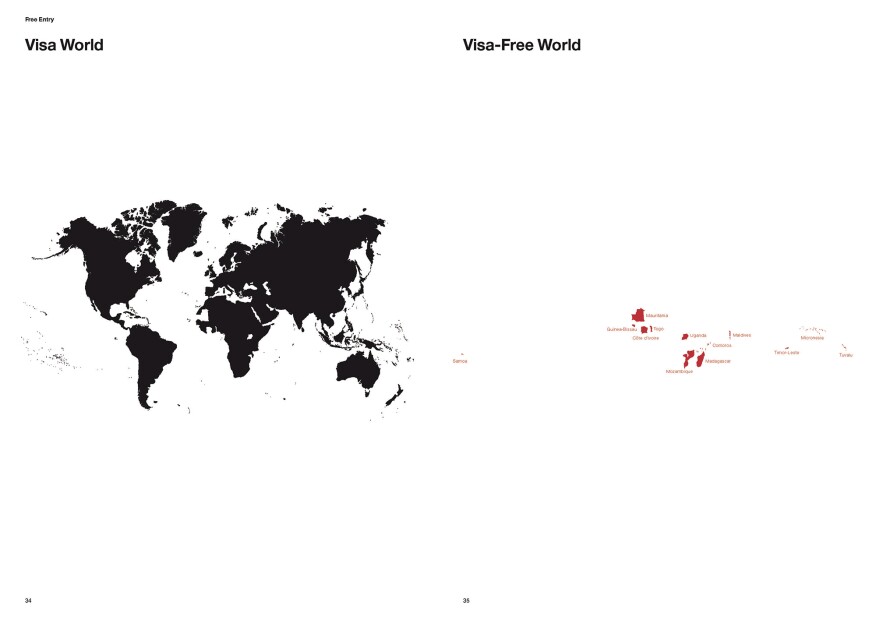“Pond. Used at the perimeter to deter intruders from entering. Piranhas can be added for an extra deadly effect.” This laconic caption to a section of a pond, which extends to the silhouette of person appearing to trip on a boulder at its shore, his or her shoe emanating a burst of red lines, and to the piranhas waiting underwater, also outlined in red, sums up the deeply ironic beauty of Theo Deutinger’s Handbook of Tyranny (Lars Müller Publishers, 2018). It is a terrifying counterpoint to the more free-ranging Arsenal of Exclusion and Inclusion I reviewed here a few weeks ago, and one that shows just how ingenious we have become at harming others through both architecture and its adjuncts.


The pond appears in the section entitled “Green Fortress,” in which Deutinger says: “Today, almost nothing can compete with nature’s image as good and beautiful. … Therefore, using nature against humans is a fantastic and unexpected trick. What looks like a lovely garden is in fact a very smartly designed low-tech fortress.” Here as throughout the book, the author goes to pains to be both neutral as to whether the fear that causes green fences and more deadly vegetation to sprout around homes is justified or not, and to show its historic precedents. The chapter starts with a drawing of the “ha-ha fence,” the method most famously used by such landscape architects as Capability Brown to keep sheep off manicured lawns while preserving an undisturbed prospect of rolling green swards from the manor house.


Most of the book, however, is more of what you would expect: a catalog of defensive walls and bollards, anti-car bomb devices, fences, and other crowd control mechanisms; containment and refugee camps; techniques for hemming in and funneling crowds; more mundane measures such as anti-graffiti paint and benches that prevent homeless from lying down on them; and, most subtle of all, blue light used to prevent suicides (on Japanese subway platforms) and drug injection (in Dutch public bathrooms; addicts can’t see their veins in that light). Flipping through the pages, it is amazing how creative designers can be when they are trying to harm, contain, or keep out people. And Deutinger’s graphic sensibility in presenting all of this is superb.

But the author doesn’t just look at the traditional accoutrements of architecture. He also collected statistics on larger aspects of containment and exclusion, like mapping which countries you can visit from where without a visa. Deutinger also picks apart a world map into drawings of those places that use “jus soli” (the type of citizenship under which you are automatically a citizen if you were born there), those that put restrictions on such a right, and those that prefer “jus sanguinis” (or racial citizenship, literally “by blood”). He gives us a map of Africa before colonial powers amalgamated its thousands of territories into states. Shorn from all the rhetoric about refugees and immigration, the maps and diagrams show just how stark the reality of separation and control is as a result of such arbitrary territorial division.

It is not just humans that are the subject of Deutinger’s delineation. The same section that contains the visa maps also shows the migration route of harriers, and the book’s most perversely beautiful section is that on slaughterhouses, whose sections of the mechanized killing route of assembly lines follow equally disturbing diagrams of methods of execution of humans around the world. (As Sigfried Giedion famously pointed out, it was in Chicago’s meatpacking district, and not at Ford’s Highland Park factory, that the assembly line first made its appearance.) Killing, Deutinger exhibits, is killing.

Killing and other forms of harming others is something we have become very good at doing. Why propagandize that ingenuity? Why treat it so lovingly with the medium of drawing we use to understand those works of architecture that elevate our spirits? “To draw is to minimize, realize, and internalize,” Deutinger explains. “Just as an atlas explains the world we inhabit, Handbook of Tyranny helps the reader to grasp the forms of cruelty in use. The experience is like standing on a watchtower with a pair of binoculars: having an overview but also a zoomed-in view of the essential details. A confrontation with cruelty is necessary first to understand it, and second to react to it. Depicting the magnitude of technology as an instrument of power and showing the myriad forms this can take, Handbook of Tyranny provides a basis for everyone who wants to fight tyranny.”
The question is whether the Handbook will have its intended effect. The very presentation the author chose will restrict its appeal to architects and designers, for whom the shudder of recognition in seeing the drawings they love to make and see employed for this purpose is itself a territorial move. Could it not be that the techniques that reduce the work of architecture and design to technical skills such as precisely scaled drawing, or the abstraction of information so that it can be more efficiently communicated, is part of what lets designers create such horrors without feeling too many ethical or moral qualms in the first place?
Having said that, Deutinger’s Handbook is by far the clearest and most beautiful of a spate of publications in the last few years that have reminded us how architecture is ultimately about command and control, even if we think it is about firmness, commodity, and delight. Let’s not fool ourselves: Let’s confront ourselves with Deutinger’s drawings, and then let’s make sure—through the kind of means I outlined in my column on gun control—that what he draws becomes a historical record.

















